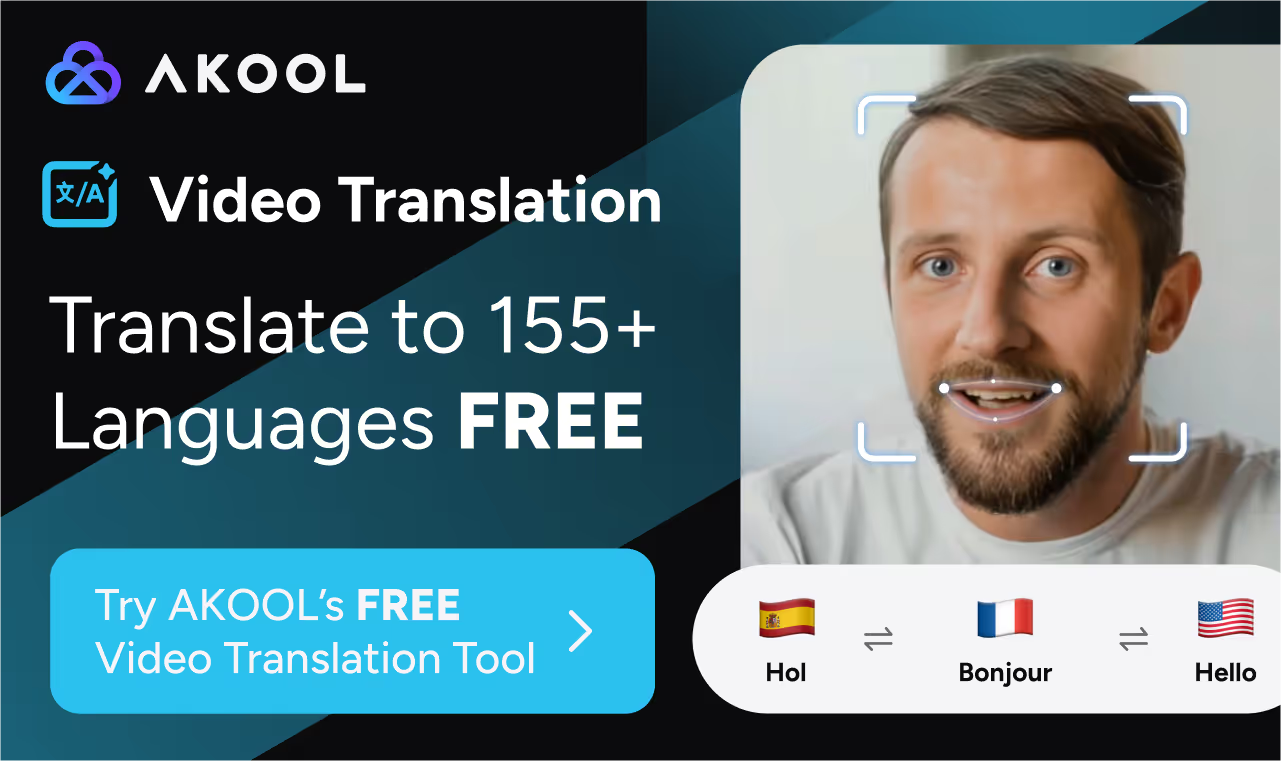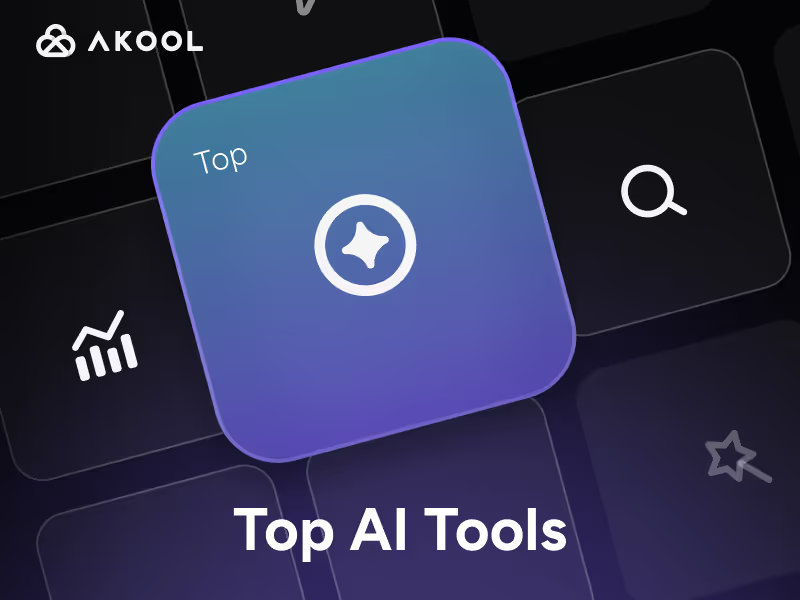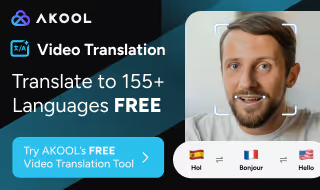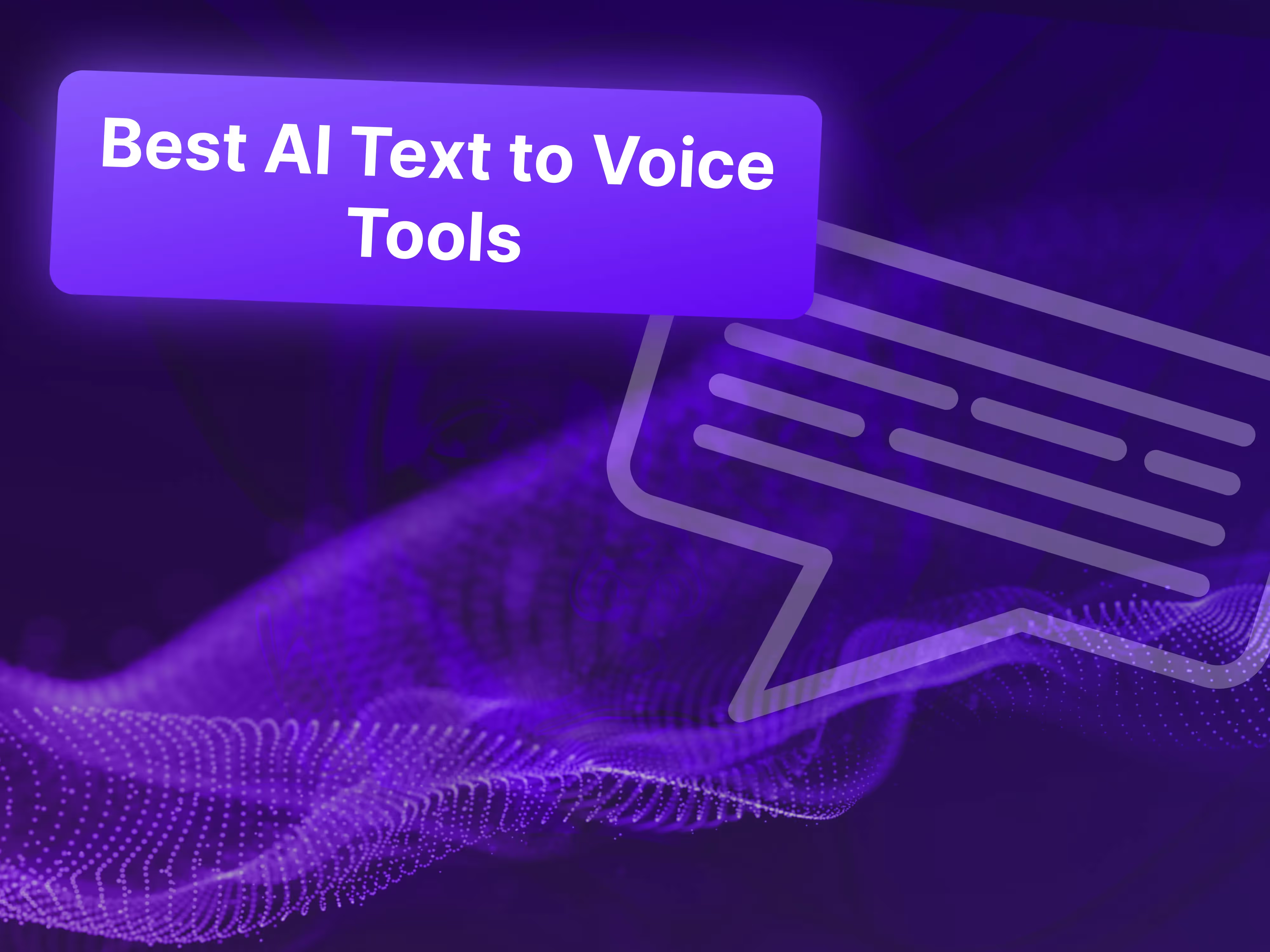AI-powered text-to-video platforms are rapidly transforming how businesses, marketers, and creators generate high-quality video content. With a surge of innovation and a crowded market, selecting the right tool can be daunting—especially when balancing creative control, automation, scalability, and integration with existing workflows. Below, we break down the top five text-to-video AI platforms, comparing their features, pricing, strengths, and unique differentiators to help you make an informed decision for your organization or creative team.
Akool: Best for Scalable, On-Brand AI Video Creation
Akool stands out as a next-generation AI video generator that streamlines the process of turning text prompts into visually compelling videos. Designed for both beginners and experienced creators, Akool offers a blend of creative control, ease of use, and seamless integration with modern text-to-video AI tools in 2025. Its robust AI models and intuitive interface make it a strong choice for businesses seeking to produce professional-quality videos for marketing, training, social media, and more.
In a market where many platforms focus on either simplicity or advanced features, Akool bridges the gap by offering multi-scene storyboarding, deep brand customization, and rapid automation. This positions it as a go-to solution for enterprises and teams that need to generate high volumes of consistent, on-brand video content—something not all competitors deliver at scale.
Product Updates in 2025
- Introduced multi-scene storyboarding for granular narrative control and branching video flows.
- Enhanced prompt-to-video fidelity for more accurate visual outputs.
- Launched a new library of customizable AI avatars with advanced lip-sync and gesture capabilities.
- Added 4K video export and expanded integrations with popular marketing and automation platforms.
Key Features
- Multi-Scene Storyboarding: Break down scripts into multiple scenes for narrative consistency and granular control. Supports both linear and branching narratives, making it ideal for interactive training or marketing content.
- Customizable AI Avatars: Access a diverse library of digital avatars with advanced lip-sync and gesture support. Personalize avatars with brand assets, languages, and voice profiles for tailored messaging.
- 4K Video Export & Automation: Generate high-resolution videos suitable for professional use. Integrate with workflow tools for automated publishing and content repurposing, reducing manual effort.
Pricing
- Free plan: Watermarked videos, limited exports.
- Pro plan: $25/month for 50 HD video generations, no watermark, priority rendering.
- Enterprise: Custom limits, API access, dedicated support.
Pros
- Intuitive interface for users of all technical backgrounds.
- Deep brand customization (logos, colors, fonts).
- Fast rendering and built-in automation for streamlined publishing.
Cons
- Free plan includes watermarks and lower export quality.
- Advanced features (like multi-scene branching) require a learning curve.
- Avatar gestures may not match the nuance of live-action footage in complex scenarios.
Use Cases
- Marketing Campaigns: Quickly generate branded promotional videos for launches and social media, eliminating the need for a dedicated video team.
- Training & Onboarding: Produce engaging training modules with avatars delivering scripts in multiple languages, supporting global teams.
- Content Repurposing: Transform written content (blogs, presentations) into dynamic videos to extend reach across platforms.
Limitations
- Watermarked exports on the free plan limit use for public-facing projects.
- Extremely long or complex scripts may require manual scene adjustments for coherence.
- Advanced motion graphics or VFX may require additional editing in third-party tools.
Unique Selling PointAkool uniquely combines multi-scene storyboarding, deep brand customization, and rapid automation, making it ideal for businesses that need scalable, on-brand AI video creation—an area where many competitors either lack depth or scalability.

Runway Gen-4: Best for Cinematic Creative Control
Runway Gen-4 is a leading AI video generator among AI video generation platforms transforming ideas into videos with AI, tailored for users who demand both automation and hands-on creative flexibility. It empowers filmmakers, marketers, and content creators to produce high-fidelity, cinematic videos from text or image prompts. Runway’s advanced creative controls and integrated editing suite set it apart in a market where many tools prioritize simplicity over depth.
Compared to platforms like Akool, which focus on brand consistency and automation, Runway excels in giving users granular control over camera movements, scene composition, and post-production editing. This makes it particularly appealing for creative professionals and agencies seeking to push the boundaries of AI-generated video.
Product Updates in 2025
- Improved camera controls and shot durations (up to 16 seconds).
- Enhanced prompt responsiveness for more accurate scene generation.
- Expanded Runway Academy resources for user training and onboarding.
Key Features
- Camera & Scene Controls: Specify camera movements, shot composition, and scene transitions for dynamic, cinematic outputs—ideal for storytelling and branded content.
- Image-to-Video & Text-to-Video: Animate still images or generate scenes from descriptive prompts, offering flexibility for various creative workflows.
- Integrated Editing Suite: AI-powered tools for background removal, slow motion, subtitles, and sound editing streamline post-production within the platform.
Pricing
- Free plan: 125 one-time credits.
- Standard plan: $15/month for 625 monthly credits, Gen-4 access, no watermark, higher export quality.
- Additional credits available for purchase.
Pros
- Advanced creative controls for detailed customization.
- Robust built-in editing tools reduce reliance on external software.
- Comprehensive educational resources via Runway Academy.
Cons
- Steep learning curve for mastering prompt engineering and camera controls.
- Credit-based pricing can lead to higher costs for long or high-quality videos.
- Occasional output inconsistencies may require multiple iterations.
Use Cases
- Short Films & Storytelling: Visualize complex narratives or cinematic sequences with precise control over every shot.
- Marketing & Social Media: Generate stylized, eye-catching videos for campaigns and brand storytelling.
- Educational Content: Produce dynamic explainer videos and tutorials with automated subtitles and visual effects.
Limitations
- High-quality or long videos can quickly exhaust monthly credit allowances.
- Lip-sync and dialogue animation are less robust than some competitors (e.g., Kling AI).
- Video rendering times may vary during peak usage.
Unique Selling PointRunway stands out for its filmmaker-friendly creative controls and integrated editing suite, offering unparalleled flexibility for users who want both automation and hands-on direction—making it the top choice for creative professionals.
OpenAI Sora: Best for Rapid Ideation and Storyboarding
OpenAI Sora leverages state-of-the-art generative models to transform simple text prompts into visually stunning video scenes. As one of the top all-in-one AI tools for script-to-video, Sora focuses on accessibility and creative experimentation, enabling users to rapidly prototype ideas or generate unique visual stories without deep technical expertise. Its seamless integration with ChatGPT makes it especially appealing for teams already using OpenAI’s ecosystem.
While Sora excels at rapid, multi-scene video generation and remixing, it’s currently limited by geographic restrictions and shorter video durations compared to platforms like Akool or Runway. However, its ease of use and innovative storyboard feature make it a strong choice for ideation, prototyping, and social media content.
Product Updates in 2025
- Launched storyboard-based multi-scene generation for narrative consistency.
- Increased output quality to 1080p on Pro plans.
- Became available via ChatGPT Plus in the US.
Key Features
- Prompt-to-Video & Storyboarding: Generate entire videos from a single prompt or build sequences scene-by-scene, ensuring visual coherence for narrative content.
- Remix & Edit: Iterate on existing videos or prompts, animate uploaded images, and experiment with different visual styles for creative flexibility.
- ChatGPT Integration: Access Sora directly through ChatGPT Plus, streamlining workflows for existing OpenAI users.
Pricing
- Included with ChatGPT Plus: $20/month for 50 video generations (5 seconds each, 720p, watermark).
- Pro plan: $200/month for 500 generations (20 seconds each, 1080p, no watermark).
Pros
- Simple, conversational interface lowers the barrier for non-technical users.
- Storyboard feature maintains consistency across multi-scene videos.
- Remix capabilities accelerate creative experimentation.
Cons
- US-only access as of 2025, limiting international adoption.
- Short video lengths on lower tiers may not suit all projects.
- Watermarks on basic plans reduce suitability for commercial use.
Use Cases
- Rapid Prototyping: Visualize concepts, storyboards, or marketing ideas quickly without extensive video editing skills.
- Social Media Content: Generate short, attention-grabbing clips for platforms like Instagram, TikTok, or Twitter.
- Remixing & Ideation: Experiment with different styles and prompt variations to refine creative direction.
Limitations
- Geographic restrictions prevent access for non-US users.
- Complex object interactions and dynamic movements may appear unnatural.
- Maximum video length is limited, especially on lower-tier plans.
Unique Selling PointSora’s seamless ChatGPT integration and innovative storyboard feature make it the most accessible tool for rapid, multi-scene video generation from text—ideal for ideation and fast-paced creative workflows.
Kling AI: Best for Cinematic Quality and Lip-Sync Precision
Kling AI is a professional-grade text-to-video platform focused on delivering realistic, filmmaker-quality videos with advanced features like lip-sync, shot extension, and detailed camera controls. For users evaluating AI video generators with text-to-speech features, Kling’s lip-sync accuracy stands out. It appeals to creators and businesses seeking precision, creative depth, and cinematic realism in their AI-generated content—areas where many mainstream platforms fall short.
Kling’s unique strengths lie in its robust lip-sync capabilities and shot extension features, making it a top choice for dialogue-driven videos, explainer content, and narrative filmmaking. While its interface and advanced controls may present a learning curve, the platform’s output quality is among the best in the industry.
Product Updates in 2025
- Kling 2.0 launched with improved lip-sync, shot extension up to three minutes, and new meme-worthy preset effects.
- Enhanced professional mode for higher accuracy and realism.
Key Features
- Lip-Sync & Dialogue Animation: Delivers accurate lip-sync for dialogue, ideal for character-driven videos and explainer content.
- Shot Extension & Sequencing: Extend shots based on previous frames, creating longer, cohesive video sequences up to three minutes.
- Filmmaker Controls: Advanced settings for camera movement, scene composition, and object placement provide granular creative direction.
Pricing
- Free plan (Kling 1.6): Limited features, long generation times.
- Professional plan: $10/month for 1080p, 10-second shots, priority access.
- Extended shot and feature upgrades available.
Pros
- Delivers some of the most realistic water, reflections, and lighting among AI video tools.
- Filmmaker-friendly features for precise storytelling.
- Robust lip-sync support for dialogue-driven content.
Cons
- Free plan users may experience hours-long waits for video generation.
- Advanced controls may overwhelm beginners or casual users.
- Some outputs may include visual anomalies or unexpected object behavior.
Use Cases
- Narrative Filmmaking: Produce short films or story-driven content with precise control over every aspect of the video.
- Explainer & Training Videos: Create engaging, dialogue-driven videos with accurate lip-sync and character animation.
- Marketing & Branding: Generate high-quality promotional content with custom camera movements and visual effects.
Limitations
- Free plan is slow and feature-limited, making it impractical for regular use.
- Mastering all controls and settings requires time and experimentation.
- Most advanced options are locked behind paid plans.
Unique Selling PointKling AI leads in lip-sync accuracy, shot extension, and filmmaker controls, making it the top choice for creators demanding cinematic quality and narrative depth—features that set it apart from more template-driven competitors.
Pika: Best for Social Media and Creative Experimentation
Pika is a flexible AI video platform that balances ease of use with creative flexibility, making it especially popular among social media creators, marketers, and digital agencies. Many influencers rely on Pika alongside AI text-to-video generators for YouTubers for quick and dynamic videos. Supporting both text-to-video and image-to-video workflows, Pika enables users to produce visually engaging content tailored to different platforms and audiences.
Whereas platforms like Akool and Runway focus on enterprise scalability or cinematic control, Pika excels at rapid, creative video generation for social media. Its unique morphing and object insertion features allow for dynamic, attention-grabbing content—perfect for digital marketers and influencers looking to stand out.
Product Updates in 2025
- Pika 2.2 added new preset actions like PikaFrames (frame morphing) and PikaAdditions (object insertion).
- Improved aspect ratio controls for social media formats.
Key Features
- Preset Actions & Morphing: Animate between frames, add objects, or morph scenes for dynamic, visually engaging content without manual editing.
- Aspect Ratio Customization: Easily tailor videos for YouTube, Instagram, TikTok, and other platforms with built-in aspect ratio presets.
- Text & Image Prompting: Generate videos from descriptive text or animate still images, expanding creative possibilities.
Pricing
- Free plan: Limited generations.
- Paid plan: $35/month for 1080p, 16-second shots, priority rendering. Discounts for annual billing or retention.
Pros
- Aspect ratio presets and quick generation make it ideal for multi-platform content.
- Built-in creative actions enable unique video effects.
- Supports both text and image inputs for flexible workflows.
Cons
- Some videos may contain errors such as object artifacts or unnatural movements.
- Higher price point than some competitors, especially for casual users.
- Dialogue and character animation are less advanced compared to Kling or Akool.
Use Cases
- Social Media Campaigns: Rapidly generate platform-specific videos for marketing, trends, or engagement, saving time and resources.
- Creative Experimentation: Test different visual styles, transitions, and effects for unique, standout content.
- Content Repurposing: Animate still images or morph between frames to refresh and extend the life of existing assets.
Limitations
- Output quality may vary, especially with complex prompts or rapid scene changes.
- Not suitable for dialogue-heavy or character-driven videos requiring accurate speech animation.
- Frequent use can quickly deplete available generations on paid plans.
Unique Selling PointPika excels at rapid, creative video generation for social media, offering unique morphing and object insertion features that simplify content creation for digital marketers and influencers—an area where more enterprise-focused platforms may lack agility.
Feature Comparison and Market Context
Across the AI text-to-video landscape, the leading platforms each carve out distinct strengths:
- Akool is best for businesses needing scalable, on-brand video creation with deep customization and automation—ideal for marketing, training, and content repurposing at scale.
- Runway Gen-4 offers unmatched creative control and integrated editing, making it the top choice for filmmakers and agencies seeking cinematic quality.
- OpenAI Sora stands out for rapid ideation, prototyping, and storyboarding, especially for teams already using ChatGPT, though it’s currently limited by geography and video length.
- Kling AI leads in cinematic realism and lip-sync precision, making it the preferred option for narrative filmmaking and dialogue-driven content.
- Pika is the go-to for social media creators and marketers who need fast, creative, and visually dynamic videos tailored to multiple platforms.
Competitor research from TechRadar, G2, Influencer Marketing Hub, VentureBeat, and Zapier highlights the importance of balancing ease of use, automation, creative flexibility, and workflow integration. While most platforms offer basic text-to-video generation, template libraries, and voiceover options, differentiation comes from advanced features like multi-scene storyboarding (Akool), filmmaker controls (Runway, Kling), and unique creative actions (Pika).
Opportunities for further differentiation include deeper integration with productivity tools, expanded support for regulated industries, and more robust compliance features—areas where enterprise buyers and large organizations are increasingly focused. Additionally, platforms that provide regular product updates, transparent pricing, and comprehensive educational resources are better positioned to serve both new and experienced users.
For businesses, agencies, and creators, the right choice will depend on your specific needs—whether it’s rapid content generation, cinematic storytelling, brand consistency, or creative experimentation. As the AI video ecosystem continues to evolve, staying informed about each platform’s latest capabilities and updates will ensure you select the best tool for your workflow and goals.
Frequently Asked Questions
How do AI text-to-video platforms work?
AI text-to-video platforms use machine learning models to turn written prompts or scripts into video scenes, often allowing for customization of visuals, avatars, and branding elements.
What are the main differences between these top platforms?
Each platform has unique strengths—some focus on creative control, others on automation, brand customization, or social media features. Your choice depends on your workflow needs and content goals.
Can I use these platforms without video editing experience?
Yes, most platforms are designed for users of all skill levels. They offer intuitive interfaces and templates, though advanced features may require some learning.
Are there limitations on free plans?
Free plans typically include watermarks, lower video quality, or limited export options. Upgrading to paid plans unlocks higher quality and more features.
Is it possible to integrate these tools with existing marketing workflows?
Many platforms offer integrations with popular marketing and automation tools, making it easier to publish and repurpose video content within your current workflow.








